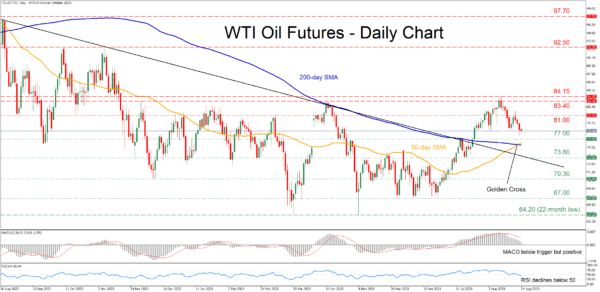WTI oil futures (October delivery) have been steadily losing ground after peaking at the nine-month high of 84.15 on August 10. Moreover, bearish pressures have not shown any sign of easing despite the completion of a golden cross between the 50- and 200-day simple moving averages (SMAs).
The momentum indicators currently suggest that bearish forces are holding the upper hand. Specifically, the MACD is softening below its red signal line but remains positive, while the RSI crossed below its 50-neutral threshold.
Should the bears attempt to push the price lower, the July resistance of 77.00 could serve as initial support. Sliding beneath that floor, the price might descend towards 73.80 before the December 2022 low of 70.30 appears on the radar. Further declines could then cease at the 67.00 hurdle, which held strong three times during May and June.
On the flipside, bullish actions could propel the price towards the March high of 81.00. Violating that zone, oil could challenge the April peak of 83.40. Even higher, 84.15, which is the highest level observed in 2023, could curb further advances.
In brief, WTI oil futures have been experiencing a correction after their solid summer rally got rejected at a fresh nine-month high. However, for the short-term technical picture to turn negative, the price needs to cross below the downward sloping trendline that connects the price’s lower highs since August 2022.














